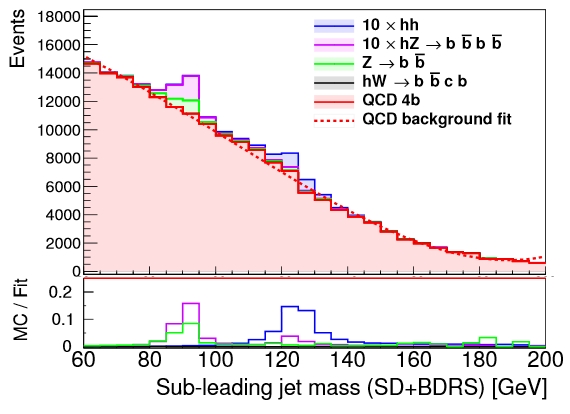While the properties of the new scalar particle discovered in 2012 by ATLAS and CMS have already started to be measured with an accuracy which leaves little doubt on the nature of the particle and its conformity to the characteristics expected for the Standard Model Higgs, there is of course a lot of room for improvement.
In particular, the issue of the value of the couplings of the Higgs would best be investigated with a different collider; but a lot can be done by a high-luminosity LHC. To study the coupling of the Higgs to different Standard Model particles one measures processes where the Higgs is produced by that particle, or decays into it.
The self-coupling, however, requires one to study the pair-production of two Higgs bosons - a process with a very low cross section. In the new article the authors consider the prospects for finding pp->HH production in events featuring four b-jets in the final state, thus exploiting the large branching fraction of H->bb decays to counter-balance the very small pair production cross section. The two main diagrams that give rise to HH production at the LHC are shown below.

The two production processes interfere destructively for certain values of the Higgs self-coupling, which adds some useful information extractable from the kinematics of the process. The diagram on the right is the relevant one however: in it you see the Higgs boson "splitting" into two copies of itself.
The collection of events with four b-jets is problematic at a hadron collider, as QCD processes that mimic that final state have a enormous rate; furthermore, at trigger level neither ATLAS nor CMS are capable of efficiently "tagging" jets from heavy-flavour quarks. The idea of the study is thus to concentrate on a boosted topology, whereby the two Higgs bosons are emitted with large transverse momentum (above 200 GeV). This strongly reduces the signal rate, but it also makes it easier to collect the events. The discrimination of the signal can then proceed online through the study of subjet properties of the two "fat" jets, and by exploiting the peculiar kinematics of the decay process.
The figure below shows what the authors predict could result from the analysis of 3000 inverse femtobarns of 14-TeV proton-proton collisions, once the tuned selection and reconstruction is performed. The invariant mass of pairs of sub-jets is shown for several concurring processes: besides the QCD background there are other resonant processes, including Z+bb and of course ZH.
 As you can see, the "excesses" with respect to the smooth QCD background, shown in the lower portion of the graph, evidence the sum of several different resonant components, and easily allow the measurement of the HH production rate.
As you can see, the "excesses" with respect to the smooth QCD background, shown in the lower portion of the graph, evidence the sum of several different resonant components, and easily allow the measurement of the HH production rate.The conclusions are that with such a large amount of data the self-coupling of the Higgs boson could be limited to be less than 120% of the SM value, if that is indeed its value. Or, of course, the signal could provide a hint of new physics.




Comments